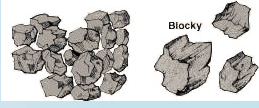soil structure | Definition and importance of soil structur | Description of soil structure | Grades of soil structure
soil structure | Definition and importance of soil structur | Description of soil structure | Grades of soil structure | Classes and types of soil structure
SOIL STRUCTURE:
Definition and importance of soil structure:
Soil structure is defined by the way individual particles of sand, silt, and clay are assembled. Single particles when assembled appear as larger particles. These are called aggregates .
Aggregation of soil particles can occur in different patterns, resulting in different soil structures. The circulation of water in the soil varies greatly according to structure, Therefore, it is important for you to know about the structure of the soil where you plan to build a fish-farm. Although you may not be able to assemble all this information yourself, the specialized technicians from the soil testing laboratory will be able to provide it after examining your undisturbed soil samples. They will be able to tell you if your soil has bad structure or good structure (pores/capillary canals, network, etc.). They will also be able to tell you about the degree of water circulation or permeability.
Description of soil structure:
Soil structure is most usefully described in terms of grade (degree of aggregation), class (average size) and type of aggregates (form). In some soils, different kinds of aggregates may be found together and they are then described separately. The following paragraphs will briefly explain the various terms which are most commonly used to describe soil structure. This will help you to judge better the quality of the soil where you plan to construct fish-ponds. It will also enable you to learn how to define the soil structure yourself when examining a soil profile. For descriptions of soil structures, see Table 17A.
Note:
the characteristic structure of a soil can be recognized best when it is dry or only slightly moist. When you are studying a soil profile to determine the grade of structure, make sure you examine a fresh profile.
Grades of soil structure:
By definition, the grade of structure is the degree of aggregation, expressing the differential between cohesion* within aggregates and adhesion* between aggregates. As these properties vary with the moisture content of the soil, grade of structure should be determined when the soil is neither unusually moist nor unusually dry. There are four major grades of structure rated from 0 to 3 as follows:
0 Structureless has no observable aggregation or no definite orderly arrangement of natural lines of weakness, such as:
- Massive structure (coherent) : where the entire soil horizon appears cemented in one great mass;
- Single-grain structure: (non-coherent) where the individual soil particles show no tendency to cling together, such as pure sand;
Weak structure:
is poorly formed from indistinct aggregates that can barely be observed in place. When removed from the profile, the soil material breaks down into a mixture of very few entire aggregates, many broken aggregates and much unaggregated material;
Moderate structure:
is well formed from distinct aggregates that are moderately durable and evident but not distinct in undisturbed soil. When removed from the profile, the soil material breaks down into a mixture of many distinct entire aggregates, some broken aggregates and little unaggregated material;
Strong structure:
goog_623304850 is well formed from distinct aggregates that are durable and quite evident in undisturbed soil. When removed from the profile, the soil material consists very largely of entire aggregates and includes few broken ones and little or no non-aggregated material.
goog_623304850 is well formed from distinct aggregates that are durable and quite evident in undisturbed soil. When removed from the profile, the soil material consists very largely of entire aggregates and includes few broken ones and little or no non-aggregated material.
Classes and types of soil structure:
By definition, class of structure describes the average size of individual aggregates. Usually, five distinct classes may be recognized in relation to the type of soil structure from which they come. They are:
- Very fine or very thin;
- Fine or thin;
- Medium;
- Coarse or thick;
- Very coarse or very thick.
By definition, type of structure describes the form or shape of individual aggregates. Generally, soil technicians recognize seven types of soil structure, but here only four types are used. They are rated from 1 to 4 as follows:
1. Granular and crumb:
structures are individual particles of sand, silt and clay grouped together in small, nearly spherical grains. Water circulates very easily through such soils. They are commonly found in the A-horizon of the soil profile;
2. Blocky and subangular blocky:
structures are soil particles that cling together in nearly square or angular blocks having more or less sharp edges. Relatively large blocks indicate that the soil resists penetration and movement of water. They are commonly found in the B-horizon where clay has accumulated;
3. Prismatic and columnar structures:
are soil particles which have formed into vertical columns or pillars separated by miniature, but definite, vertical cracks. Water circulates with greater difficulty and drainage is poor. They are commonly found in the B-horizon where clay has accumulated;
4 .Platy structure :
is made up of soil particles aggregated in thin plates
QUIZ PRACTICE
RCC
RCC-1 -Click here
RCC-2- Click here
𐩘𐩘𐩘𐩘𐩘𐩘𐩘𐩘𐩘𐩘𐩘𐩘𐩘𐩘𐩘𐩘𐩘𐩘𐩘𐩘
SOM/MOS
𐩘𐩘𐩘𐩘𐩘𐩘𐩘𐩘𐩘𐩘𐩘𐩘𐩘𐩘𐩘𐩘𐩘𐩘𐩘𐩘
𐩘𐩘𐩘𐩘𐩘𐩘𐩘𐩘𐩘𐩘𐩘𐩘𐩘𐩘𐩘𐩘𐩘𐩘𐩘𐩘𐩘
𐩘𐩘𐩘𐩘𐩘𐩘𐩘𐩘𐩘𐩘𐩘𐩘𐩘𐩘𐩘𐩘𐩘𐩘𐩘𐩘𐩘
















COMMENTS